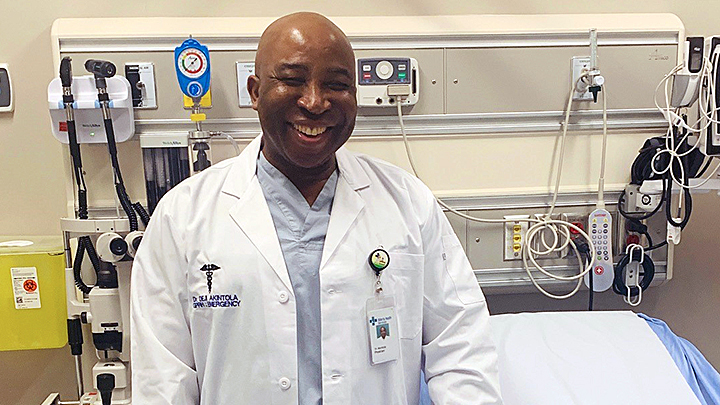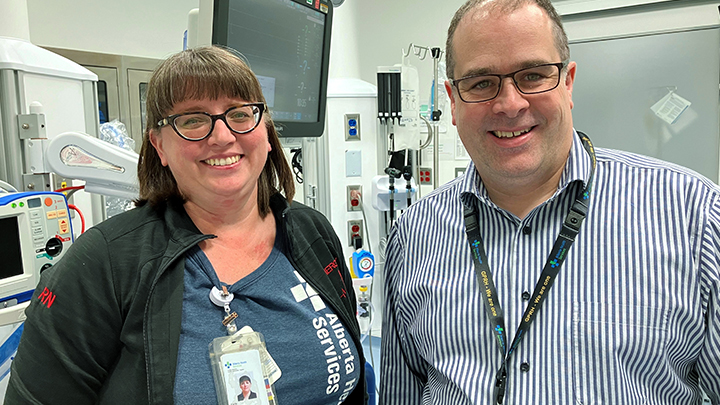
May 27, 2024

Dr. Deji Akintola, chief medical officer, stands bedside in the Grande Prairie Regional Hospital Emergency Department, where changes are taking place to enhance overall patient care. Photo by Lisa Laferriere.

Greg Schmidt, director of patient care, and Carla Reany, GPRH emergency department unit manager, visit one of the unit’s trauma bays. They are members of the team involved in improving the patient experience here. Photo by Sara Blake.
Story & photo by Sara Blake | Photo by Lisa Laferriere
GRANDE PRAIRIE — What started as a response to patient feedback has led to a transformation of Emergency Department (ED) processes — and improved patient flows and reduced wait times — at Grand Prairie Regional Hospital (GPRH).
For many patients, their first hospital experience will be in the ED. Several factors — including patient intake, patient registration process and recruitment success — can shape their overall patient experience.
Keeping this in mind, the GPRH has made significant strides in improving the patient experience in their emergency department (ED). After listening to patient concerns, the hospital revamped its registration process to streamline patient intake.
“The new patient-registration process was implemented as a result of patient feedback,” says Carla Reany, ED unit manager at GPRH.
“We listened to their suggestions, and I think it’s working well. With the new process, the initial wait is more organized. It allows us to keep track of all patients coming into the Emergency Department and helps to streamline the triage process.”
Under the new system, ED patients are efficiently organized upon arrival. A patient’s condition determines their next steps after being triaged.
Those with less-severe illness or injuries are directed to Zone F, where they receive attention for minor interventions, such as stiches or a cast. This area is dedicated to lower-acuity patients and operates seven days a week, 9 a.m. to 11 p.m.
Patients with more serious conditions are directed to the main ED. These patients are greeted with a new intake process at Zone A, for streamlined assessments and initial patient workups. This helps ensure higher-acuity patients receive prompt attention and treatment.
“Our higher-risk patients are assessed by a physician or a nurse in Zone A,” says Dr. Deji Akintola, chief medical officer for the GPRH ED. “They’ll have an initial workup and, depending on their care needs, they may be able to go back to the waiting room and wait for results there.
“This helps us get eyes on our higher-acuity patients faster and expedite their visit. Depending on the workup results, patients could get to a stretcher space sooner, while others might even be discharged right from the waiting room, allowing us to keep more ED spaces available for those who need them most.”
The team’s successful recruitment efforts have also reduced ED wait times. GPRH has opened its doors to new staff and anticipates welcoming more.
“We’ve hired a ton of new staff over the last year-and-a-half,” says Greg Schmidt, GPRH patient care director for the ED. “Now, we’re focusing on training the new staff in the unique skills required for working within the department, while at the same time prioritizing retaining our existing experienced staff.”
In the coming months, three more physicians, each equipped with an additional five years of specialized emergency medicine training, will be joining the GPRH ED team.
"Adding three emergency medicine specialists is great for our department and the larger community we serve as a regional healthcare site,” says Dr. Akintola. “We’ll be better equipped to meet the needs of our busy ED and provide the best possible care to our patients.”
In addition to a growing team, the ED has also expanded its capacity with four new acute-treatment spaces to accommodate patients who require closer cardiac monitoring.
Another outcome of patient feedback is the establishment of a quiet waiting area, designed for those with sensory issues.
“We’ve set up a room with a few sensory chairs,” Reany says. “It’s still in the ED, but away from the very busy waiting room. We’re using this new area to accommodate families with children who have specific sensory needs, such as those with autism. It’s a safe space, that’s not over-stimulating, where patients can wait to see a doctor.”
In late 2022, GPRH became the first facility in the North Zone to have ED wait times posted online and on the AHS mobile app.
“The more information people have, the less anxious they typically are about their visit,” adds Reany. “If they know approximately how long it might take, then they can prepare by maybe bringing something to keep their kids busy.”
When seeking care at any Emergency Department, it’s important to remember that priority is given to the sickest patients and no patients will be turned away. If you require emergency care, Alberta’s Emergency Departments and our healthcare teams are here for you.
However, if you’re not experiencing an emergency, the ED may not be the most appropriate place to get the care you need. For less immediate or non-emergency needs, alternative options such as family doctors, community health clinics, Health Link and pharmacies are available to assist you.
For more information on how to find the right care for you or your family, visit ahs.ca/options.